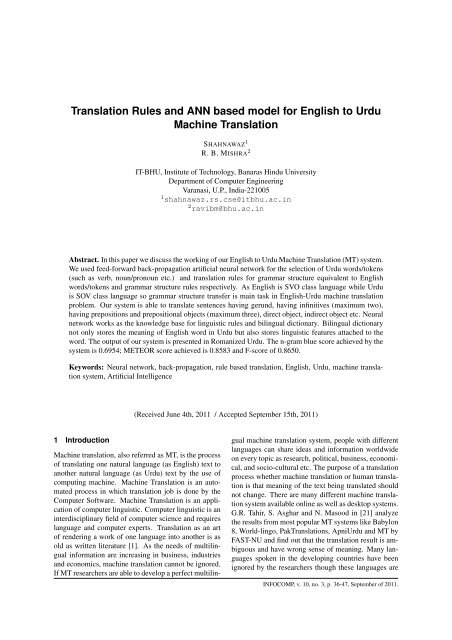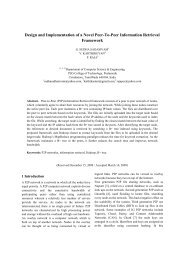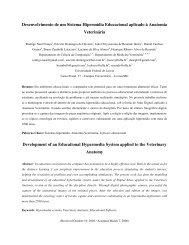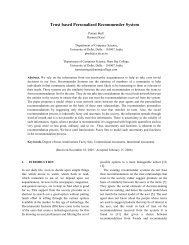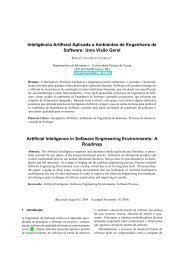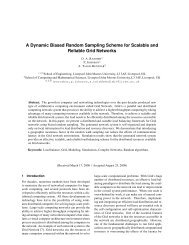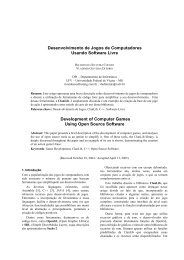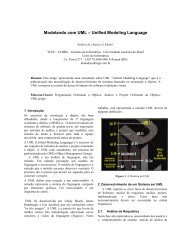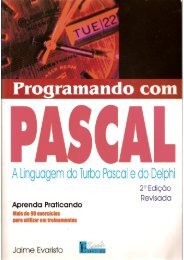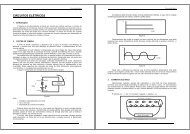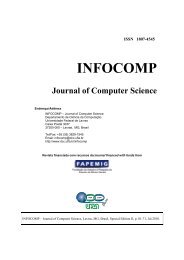INFOCOMP - Departamento de Ciência da Computação - Ufla
INFOCOMP - Departamento de Ciência da Computação - Ufla
INFOCOMP - Departamento de Ciência da Computação - Ufla
Create successful ePaper yourself
Turn your PDF publications into a flip-book with our unique Google optimized e-Paper software.
Translation Rules and ANN based mo<strong>de</strong>l for English to Urdu<br />
Machine Translation<br />
SHAHNAWAZ 1<br />
R. B. MISHRA 2<br />
IT-BHU, Institute of Technology, Banaras Hindu University<br />
Department of Computer Engineering<br />
Varanasi, U.P., India-221005<br />
1 shahnawaz.rs.cse@itbhu.ac.in<br />
2 ravibm@bhu.ac.in<br />
Abstract. In this paper we discuss the working of our English to Urdu Machine Translation (MT) system.<br />
We used feed-forward back-propagation artificial neural network for the selection of Urdu words/tokens<br />
(such as verb, noun/pronoun etc.) and translation rules for grammar structure equivalent to English<br />
words/tokens and grammar structure rules respectively. As English is SVO class language while Urdu<br />
is SOV class language so grammar structure transfer is main task in English-Urdu machine translation<br />
problem. Our system is able to translate sentences having gerund, having infinitives (maximum two),<br />
having prepositions and prepositional objects (maximum three), direct object, indirect object etc. Neural<br />
network works as the knowledge base for linguistic rules and bilingual dictionary. Bilingual dictionary<br />
not only stores the meaning of English word in Urdu but also stores linguistic features attached to the<br />
word. The output of our system is presented in Romanized Urdu. The n-gram blue score achieved by the<br />
system is 0.6954; METEOR score achieved is 0.8583 and F-score of 0.8650.<br />
Keywords: Neural network, back-propagation, rule based translation, English, Urdu, machine translation<br />
system, Artificial Intelligence<br />
(Received June 4th, 2011 / Accepted September 15th, 2011)<br />
1 Introduction<br />
Machine translation, also referred as MT, is the process<br />
of translating one natural language (as English) text to<br />
another natural language (as Urdu) text by the use of<br />
computing machine. Machine Translation is an automated<br />
process in which translation job is done by the<br />
Computer Software. Machine Translation is an application<br />
of computer linguistic. Computer linguistic is an<br />
interdisciplinary field of computer science and requires<br />
language and computer experts. Translation as an art<br />
of ren<strong>de</strong>ring a work of one language into another is as<br />
old as written literature [1]. As the needs of multilingual<br />
information are increasing in business, industries<br />
and economics, machine translation cannot be ignored.<br />
If MT researchers are able to <strong>de</strong>velop a perfect multilingual<br />
machine translation system, people with different<br />
languages can share i<strong>de</strong>as and information worldwi<strong>de</strong><br />
on every topic as research, political, business, economical,<br />
and socio-cultural etc. The purpose of a translation<br />
process whether machine translation or human translation<br />
is that meaning of the text being translated should<br />
not change. There are many different machine translation<br />
system available online as well as <strong>de</strong>sktop systems.<br />
G.R. Tahir, S. Asghar and N. Masood in [21] analyze<br />
the results from most popular MT systems like Babylon<br />
8, World-lingo, PakTranslations, ApniUrdu and MT by<br />
FAST-NU and find out that the translation result is ambiguous<br />
and have wrong sense of meaning. Many languages<br />
spoken in the <strong>de</strong>veloping countries have been<br />
ignored by the researchers though these languages are<br />
<strong>INFOCOMP</strong>, v. 10, no. 3, p. 36-47, September of 2011.


